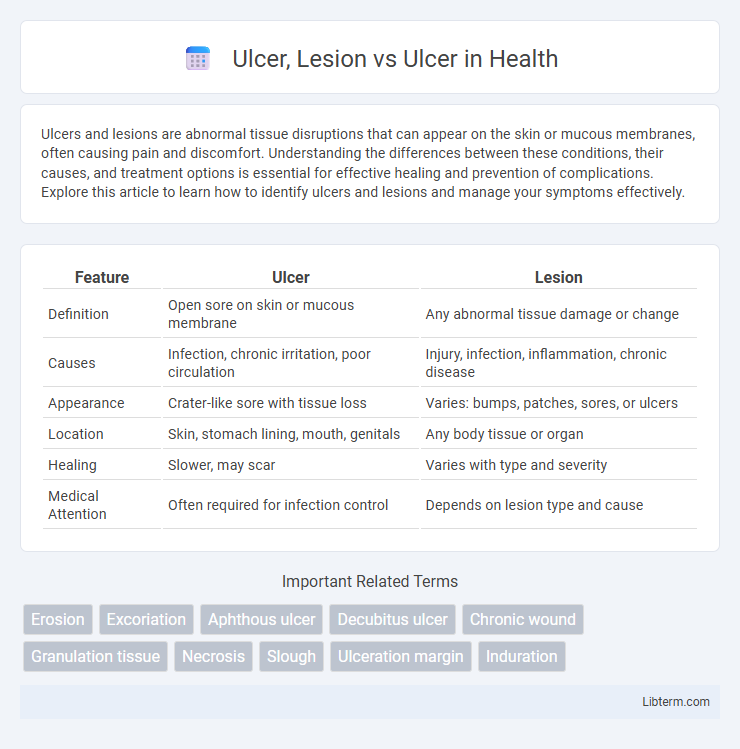Ulcers and lesions are abnormal tissue disruptions that can appear on the skin or mucous membranes, often causing pain and discomfort. Understanding the differences between these conditions, their causes, and treatment options is essential for effective healing and prevention of complications. Explore this article to learn how to identify ulcers and lesions and manage your symptoms effectively.
Table of Comparison
| Feature | Ulcer | Lesion |
|---|---|---|
| Definition | Open sore on skin or mucous membrane | Any abnormal tissue damage or change |
| Causes | Infection, chronic irritation, poor circulation | Injury, infection, inflammation, chronic disease |
| Appearance | Crater-like sore with tissue loss | Varies: bumps, patches, sores, or ulcers |
| Location | Skin, stomach lining, mouth, genitals | Any body tissue or organ |
| Healing | Slower, may scar | Varies with type and severity |
| Medical Attention | Often required for infection control | Depends on lesion type and cause |
Understanding Ulcers: Definition and Types
Ulcers are open sores or wounds on the skin or mucous membranes, often caused by inflammation, infection, or prolonged pressure. Lesions refer to any abnormal tissue changes, including ulcers, but also encompass a broader range of conditions such as tumors, rashes, and scars. Understanding the distinction between ulcers and lesions is crucial for accurate diagnosis and targeted treatment strategies in clinical practice.
What Is a Lesion? Medical Meaning and Classification
A lesion refers to any abnormal tissue damage or change, including wounds, ulcers, tumors, or infections, that disrupts the normal structure or function of the skin or internal organs. In medical classification, lesions are categorized by their appearance, cause, and depth, such as macules, papules, nodules, or ulcers, which specifically represent open sores with tissue loss. Understanding lesion types helps medical professionals accurately diagnose conditions and differentiate ulcers, which are a subset of lesions characterized by full-thickness tissue erosion.
Key Differences Between Lesions and Ulcers
Lesions refer to any abnormal tissue changes or damage on the skin or mucous membranes, ranging from benign spots to malignant growths, while ulcers are a specific type of lesion characterized by open sores with a loss of surface tissue. Ulcers often result from prolonged pressure, infection, or underlying conditions like diabetes or vascular disease, and they tend to heal slowly due to tissue necrosis and inflammation. Key differences include ulcers being a subset of lesions with an open crater-like wound, whereas lesions can be closed or raised abnormalities without surface loss.
Common Causes of Ulcers
Ulcers are open sores or lesions that occur on the skin or mucous membranes, with lesions encompassing a broader category of abnormal tissue changes. Common causes of ulcers include Helicobacter pylori infection, prolonged NSAID use, stress-related mucosal damage, and chronic diseases such as diabetes. Unlike general lesions, ulcers specifically result from tissue breakdown and impaired healing caused by factors like ischemia, infection, or pressure.
Typical Causes of Lesions
Lesions often result from infections, trauma, or inflammatory conditions, causing localized tissue damage that may not necessarily break the skin or mucous membrane. Ulcers are a specific type of lesion characterized by a full-thickness loss of the epidermis and often extend into the dermis, commonly caused by prolonged pressure, poor circulation, or underlying systemic diseases like diabetes. Typical causes of lesions include bacterial or viral infections, physical injury, and immune-mediated disorders, while ulcers frequently arise from ischemia, venous stasis, or repetitive mechanical stress.
Clinical Presentation: How Ulcers and Lesions Appear
Ulcers typically present as open sores with a well-defined, often necrotic base accompanied by varying degrees of inflammation and edema, whereas lesions encompass a broader range of skin abnormalities, including rashes, nodules, or plaques without necessarily having an open or necrotic component. Ulcerative lesions show tissue breakdown and may involve underlying structures, leading to pain, redness, and sometimes exudate. Clinical evaluation distinguishes ulcers by their depth and chronicity, contrasting with lesions that may be superficial and limited to epidermal changes.
Diagnostic Approaches: Distinguishing Lesions from Ulcers
Diagnostic approaches to distinguish lesions from ulcers involve a combination of clinical examination and advanced imaging techniques, such as dermoscopy and biopsy. Ulcers typically present as full-thickness loss of the epidermis and part of the dermis with a well-defined base, whereas lesions may vary broadly in morphology, including raised or flat abnormalities without tissue breakdown. Accurate diagnosis relies on histopathological analysis to differentiate ulcerative conditions from other lesion types, ensuring appropriate treatment planning.
Treatment Options for Ulcers
Treatment options for ulcers vary depending on the ulcer type and severity, often including antibiotics for bacterial infections such as Helicobacter pylori-associated ulcers, proton pump inhibitors (PPIs) to reduce stomach acid, and lifestyle modifications like diet changes and smoking cessation. Lesions, which may refer to a broader range of tissue abnormalities, require precise diagnosis to distinguish from ulcers; treatment may range from observation to surgical intervention based on lesion pathology. Understanding the specific ulcer type, whether peptic, diabetic foot, or pressure ulcers, guides targeted therapies to promote healing and prevent complications such as infection or chronicity.
Management Strategies for Lesions
Management strategies for lesions focus on accurate diagnosis, wound care, and preventing infection, often employing debridement, topical antibiotics, and appropriate dressings. Lesions require tailored treatment plans based on their etiology, size, and depth, with close monitoring to avoid progression to ulcers. Early intervention and patient education on hygiene and lifestyle modifications play a crucial role in effective lesion management.
Prevention Tips: Reducing Risk of Ulcers and Lesions
Ulcers and lesions differ primarily in their formation, with ulcers being open sores often caused by prolonged pressure or infection, while lesions are broader abnormalities in tissue structure. Prevention tips include maintaining proper hygiene, managing chronic conditions like diabetes, and using protective barriers to reduce skin friction. Regularly inspecting skin for early signs, staying hydrated, and ensuring adequate nutrition also significantly reduce the risk of developing both ulcers and lesions.
Ulcer, Lesion Infographic

 libterm.com
libterm.com